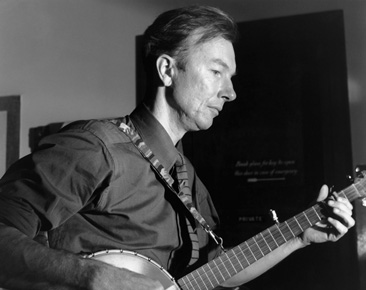
“To my old brown earth and to my old blue sky, I’ll now give these last few molecules of ‘I’.” – Pete Seeger
 When I arrived in New York City, I had the good fortune to play at the Greenwich Folk Festival in Greenwich Village, then considered to be the heart of the folk music scene. And one of the biggest hearts belonged to Pete Seeger. Backstage, he was always warm, welcoming, and nurturing — setting an example that I still try to follow today. As part of a roots music concert tour, we rode in the van together to the shows and I loved listening to him talk (not surprisingly, he was a great storyteller!).
When I arrived in New York City, I had the good fortune to play at the Greenwich Folk Festival in Greenwich Village, then considered to be the heart of the folk music scene. And one of the biggest hearts belonged to Pete Seeger. Backstage, he was always warm, welcoming, and nurturing — setting an example that I still try to follow today. As part of a roots music concert tour, we rode in the van together to the shows and I loved listening to him talk (not surprisingly, he was a great storyteller!).
We made our own stories, too. One time we were at this lodge in upper state NY for a convention of the People’s Music Network and it just so happened that Pete didn’t have an instrument with him. All the musicians were doing a round robin, picking for a bit and then sitting down to let the next musician play. When it came around to Pete, he stood up on his chair and told a little story about what he was going to do and then he started hamboning while the crowd roared it’s approval. He brought music with him wherever he went. I had such an admiration for him as a performer… even without an instrument he could mesmerize a room full of musicians.
I had been working on collecting interviews for the documentary, Making Music with the Pioneers of Bluegrass, when I got a call from the International Bluegrass Music Museum in Owensboro, KY, asking if I would do an interview with Pete Seeger for their Oral History Project. Seems that back in the ’70s, Pete had donated his banjo to support a fundraising effort for the folk music community. This was the banjo that he had played for more than 15 years at protest rallies in the 60s and it featured his slogan “This machine surrounds hate and forces it to surrender” on the head. The IBMM had just acquired this banjo from a private individual to display at the museum and they wanted folks to be able to connect with the instrument through a recorded interview with this living legend. Of course I jumped at the chance and headed off to Beacon, NY to meet with Pete, now 87 years old. Now, the Clearwater Meeting House where we held the interview had this wood-burning fireplace. When I arrived with the crew, we found Pete outside splitting logs for the fireplace so we could be warm during the meeting. That was classic Pete, always thinking of others first.
I remember when the interview was over he shook our hands, tossed his ax and the remaining firewood in the bed of his beat up old pickup truck and then proceeded to back right into the front of my van before taking off like a shot. The crew and I just looked at each other in shock and then busted out laughing. It was a fitting end to the whole meeting. I’m proud to say that I still have that dent in my front bumper — probably should get a “Pete Seeger was here” sign painted over it!
Pete is still a controversial figure in bluegrass music circles. Most bluegrassers contend that Pete was not a bluegrass musician. But take a look at what he has done for our genre. His book on 5-String Banjo Instruction was the one of the seminal books for beginning banjo pickers and acknowledges bluegrass along with other styles. He brought international attention to bluegrass music when he helped produce the “Folksong ‘59” show with Alan Lomax at Carnegie Hall which featured relatively unknown bluegrass musicians Earl Taylor and the Stoney Mountain Boys (including my long time friend and fellow recording artist, Walter Hensley). His TV show Rainbow Quest ran on public television from 1965-66 and brought guests like The Stanley Brothers, Greenbriar Boys, Doc Watson, Roscoe Holcomb, Cousin Emmy to the attention of the viewers all over the east coast (12 episodes of these rare performances are available on DVD now).
To paraphrase one of his famous quotes, “We’re all different, but we’re all singing together. It gives you hope.” When we start naming things, we put them in little boxes. I just don’t think music should be put in a box. Because he embraced American culture and the arts, Pete Seeger is bigger than any one musical genre. His influence is still being felt by generations of banjo pickers across the whole musical spectrum. Though he’s gone physically from this world, Pete will always live on…outside the box.
 About James Reams: James Reams has been the bandleader for James Reams & The Barnstormers for over 20 years. Nominated by IBMA in 2002 as Emerging Artist of the Year and Recording Event of the Year, this nationally-known band provides a contemporary take on traditional bluegrass; blending it with innovation and vitality to create their own branch on the “roots” tree. Coming from a family of traditional singers in southeastern Kentucky, James has played both old-time and bluegrass music since he was just a sprout. Known as an “Ambassador of Bluegrass” for his dedication to and deep involvement in the thriving bluegrass and Americana music community, James is involved in just about everything related to bluegrass. For the past 14 years, James has coordinated the Park Slope Bluegrass & Old Time Music Jamboree. And, in 2013, he released his second full-length DVD documentary, Making History with Pioneers of Bluegrass which he hosted and produced. More information is available on his website: www.jamesreams.com. For bookings: james@jamesreams.com or 718-374-1086.
About James Reams: James Reams has been the bandleader for James Reams & The Barnstormers for over 20 years. Nominated by IBMA in 2002 as Emerging Artist of the Year and Recording Event of the Year, this nationally-known band provides a contemporary take on traditional bluegrass; blending it with innovation and vitality to create their own branch on the “roots” tree. Coming from a family of traditional singers in southeastern Kentucky, James has played both old-time and bluegrass music since he was just a sprout. Known as an “Ambassador of Bluegrass” for his dedication to and deep involvement in the thriving bluegrass and Americana music community, James is involved in just about everything related to bluegrass. For the past 14 years, James has coordinated the Park Slope Bluegrass & Old Time Music Jamboree. And, in 2013, he released his second full-length DVD documentary, Making History with Pioneers of Bluegrass which he hosted and produced. More information is available on his website: www.jamesreams.com. For bookings: james@jamesreams.com or 718-374-1086.







